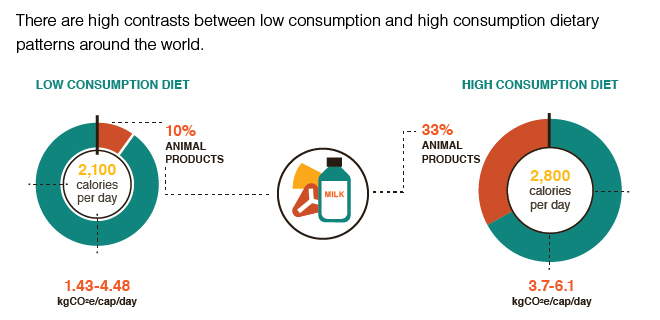Diets

Facts
- Globally, food consumption patterns are changing in terms of both total amount and composition. Consumption of animal products, vegetable oils and sugar-sweeteners is increasing in low- and middle-income countries—a so-called Westernization of the diet. However, consumption of animal protein, animal fat and vegetable oil intake is still significantly higher in high-income countries than in low- and middle-income countries (Pradhan et al. 2013).
- The amount of fossil fuel used in agriculture and total greenhouse gas emissions of agricultural systems generally increase as diets become more calorie rich (Pradhan et al. 2013).
- Reducing the amount of meat people consume could significantly reduce greenhouse gas emissions. However, current trends point in the opposite direction (Pradhan et al. 2013).
- Very high calorie diets are common in high-income countries and are associated with high total per capita greenhouse gas emissions (3.7–6.1 kg of carbon dioxide [CO2] equivalent per day) due to high carbon intensity and high intake of animal products (Pradhan et al. 2013).
- However, greenhouse gas emissions associated with low calorie diets, which are common in low- and middle-income countries, are similar in emissions burden to those associated with moderate and high calorie diets (1.43–4.48 kg of CO2 equivalent per person per day). This is because agricultural systems in low- and middle-income countries produce fewer calories per unit of greenhouse gas emissions. Non-CO2 greenhouse gas emissions contribute a relatively high share of the total emissions for the low and the moderate calorie diets. In high-income countries, a relatively larger percentage of the emissions stem from the consumption of fossil fuels (Pradhan et al. 2013).
- As incomes increase, so too does people’s food energy consumption and they also tend to consume more higher-value foods, such as meat and milk. If these trends continue, global agricultural non-CO2 greenhouse gas emissions are predicted to rise by 76% compared with baseline conditions (unchanged 1995 consumption levels). In contrast, if meat consumption were to reduce by 25%, non-CO2 greenhouse gas emissions would decrease by 51% compared with the baseline scenario (Popp et al. 2010).
- If everyone were to reduce their meat consumption, or even switch completely to plant-based protein food, up to 2,700 million hectares of pasture and 100 million hectares of cropland could be abandoned, resulting in a large carbon uptake from regrowing vegetation. Additionally, non-CO2 greenhouse gas emissions (methane and nitrous oxide) would be reduced substantially (Stehfest et al. 2009).
- A global transition to a low-meat-diet would halve the cost of mitigation actions needed to achieve a 450 ppm CO2 equivalent stabilization target in 2050 (Stehfest et al. 2009).
Sources and further reading
- Popp A, Lotze-Campen H, Bodirsky B. 2010. Food consumption, diet shifts and associated non-CO2 greenhouse gases from agricultural production. Global Environmental Change 20:451–462. (Available from http://dx.doi.org/10.1016/j.gloenvcha.2010.02.001)
- Pradhan P, Reusser DE, Kropp JP. 2013. Embodied greenhouse gas emissions in diets. PLoS ONE 8(5):e62228. doi:10.1371/journal.pone.0062228.
- Stehfest E, Bouwman AF, van Vuuren DP, den Elzen MGJ, Eickhout B, Kabat P. 2009. Climate benefits of changing diet. Climatic Change 95:83–102. DOI 10.1007/s10584-008-9534-6.